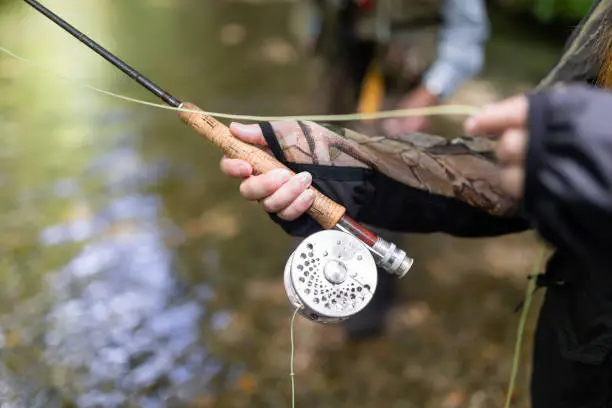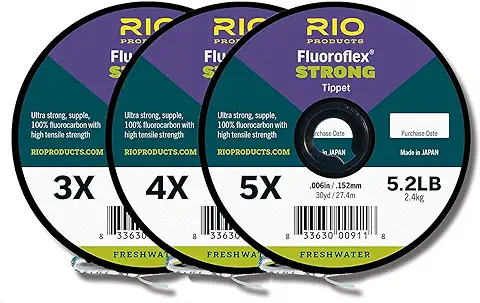How to Choose the Right Tippet Size for Successful Fly Fishing

Fly fishing is a delicate and intricate art that requires attention to detail and precision. One of the critical elements in fly fishing is selecting the proper tippet for your fly.
The tippet is the final section of the line that connects the fly to the leader. The correct tippet size is crucial for achieving a natural drift, proper presentation, and successful hook sets.
This comprehensive guide will explore everything you need to know about selecting the perfect tippet for your fly fishing endeavors.
Must Read: An In-depth Guide on Fly Fishing Tippet
Also: Understanding Fly Fishing Leaders and Tippets? Expert Guide (2024)
Understanding Tippet and Leader Materials
Before diving into the specifics of tippet selection, let’s take a moment to understand the materials used in tippets and leaders. The two main types of materials used are monofilament and fluorocarbon.
Monofilament is the most commonly used material for tippets and leaders. It is known for its versatility, affordability, and ease of use. Monofilament tippets are suitable for various fishing conditions and can handle multiple fly sizes.
Fluorocarbon, on the other hand, offers some distinct advantages over monofilament. Its higher density makes it sink faster and less visible in the water. Fluorocarbon tippets are also more abrasion-resistant and have a higher strength-to-diameter ratio.
However, fluorocarbon tippets are more expensive than monofilament and require proper lubrication when tying knots to prevent breakage.
Both monofilament and fluorocarbon tippets have their place in fly fishing, and the choice between them depends on factors such as water conditions, target species, and personal preference.
How to Choose the Right Tippet Size
Choosing the correct tippet size is crucial for achieving a natural drift and fooling wary fish. The general rule of thumb is to match the tippet size to the size of the fly you are using. The larger the fly, the thicker the tippet should be.
Conversely, smaller flies require thinner tippets for a more delicate presentation.

To determine the appropriate tippet size, refer to a simple formula: divide the fly size by three. For example, if you use a size 18 fly, dividing it by three gives you a tippet size of 6X.
This formula provides a good starting point, but remember that there are exceptions and variations depending on fishing conditions and personal preferences.
The table below provides a breakdown of tippet sizes, diameter, approximate breaking strength, and the corresponding fly sizes that pair well with each tippet size:
| Tippet Size | Tippet Diameter | Approximate Breaking Strength (lbs) | Balances with Fly Sizes |
|---|---|---|---|
| 8X | .003″ | 1.75 | 22, 24, 26, 28 |
| 7X | .004″ | 2.5 | 18, 20, 22, 24 |
| 6X | .004″ | 3.5 | 16, 18, 20, 22 |
| 5X | .006″ | 4.75 | 14, 16, 18 |
| 4X | .007″ | 6 | 12, 14, 16 |
| 3.5X | .008″ | 8.5 | 6, 8, 10 |
| 2X | .009″ | 11.5 | 4, 6, 8 |
| 1X | .010″ | 13.5 | 2, 4, 6 |
| 0X | .011″ | 15.5 | 1/0, 2, 4 |
| .012 | .012″ | 18.5 | 5/0, 4/0, 3/0, 2/0 |
| .013 | .013″ | 20 | 5/0, 4/0, 3/0, 2/0 |
| .015 | .015″ | 25 | 5/0, 4/0, 3/0, 2/0 |
Recommended: How To Fish Emerger For Trout
Tippet Length and Function
Length
The length of your tippet depends on where you’re fishing. For warm water fish like bass or saltwater species, a 6-8ft leader with the last 12 inches being tippet is common.
Shorter leaders are used in small trout streams where casting isn’t needed much. In these cases, add a 2-foot section to a 7.5ft leader.
On medium-sized trout streams with riffles or white water, use a 7.5ft-9ft leader with 12 inches of tippet. The rough water breaks up the tippet’s visibility to fish, allowing for a shorter length.
The most common length is a 9ft leader with 12-18 inches of tippet, suitable for most trout streams. For lake fishing or calm rivers where visibility is an issue, use an 11-13ft leader with 18–24inch tippet.
When fish are spooky, extend the tippet up to 4ft on a longer leader.
Function
Tippet prolongs the life of your leader. Just a 12-inch section lets you change flies without affecting the leader. When tippet gets short, snip it off and tie a new section on.
Besides extending leader life, tippet adds stealth for spooky fish. Experiment to find the right length and diameter. If fish shy away from your fly, extend or size down the tippet until they can’t see the line.
Tippet also allows you to add a trailing fly to your setup, like a dropper pattern or a tandem rig. It’s handy for many options!
Recommended: Understanding Leaders And Tippets
Balancing Tippet Diameter and Breaking Strength
When selecting a tippet, it’s essential to consider the diameter and breaking strength. Tippet diameter refers to the thickness of the tippet material while breaking strength indicates the force required to break the tippet.
These recommendations serve as a helpful starting point, but it’s important to note that fishing conditions and personal preferences may require adjustments. Factors such as water clarity, target species, and fishing pressure can influence the choice of tippet size.
Factors to Consider When Selecting Tippet Size for Trout Fishing

When it comes to trout fishing, selecting the right tippet size is crucial for fooling selective trout. Here are some factors to consider when choosing the appropriate tippet size for trout:
Fly Type
The type of fly you are using plays a significant role in determining the appropriate tippet size. Dry flies, nymphs, streamers, and wet flies have different weights and sizes, requiring different tippet sizes for optimal presentation.
For example, delicate dry flies may require a thinner tippet to achieve a natural drift, while larger streamers may need a thicker tippet to handle the weight and ensure a secure hook set.
Water Conditions
Water conditions, such as clarity and flow, can influence the visibility of tippets. In clear water, trout are more likely to scrutinize your presentation, making it necessary to use thinner tippets to avoid detection.
In turbid or fast-flowing water, thicker tippets can provide the strength to handle aggressive strikes and navigate obstacles.
Trout’s Visual Acuity
Trout have excellent eyesight and can detect unnatural presentations. Choosing a too thick or visible tippet can spook trout and result in fewer bites.
Thinner tippets, such as 6X or 7X, offer greater invisibility, making your fly appear more natural and enticing to trout.
Fly Size and Type
Here are some factors to consider when choosing the appropriate tippet size for trout depending on fly size and type:
Dry Fly
When using dry flies, it’s best to add a section of monofilament tippet to your leader. The tippet size usually ranges from 4X to 7X, depending on your leader and fly size.
Smaller flies need a higher number of tippets, while more giant flies need a lower number of tippets. Always match your leader size or use one size smaller. Monofilament is less visible in water compared to fluorocarbon and helps the fly float better.
Nymph
For nymph or midge fishing, use a fluorocarbon tippet that matches or is one size smaller than your leader. Fluoro tippet helps your fly sink faster to the desired water depth.
Although more visible, it provides added strength when fishing tiny midges to big fish. When using a double nymph rig, refer to the fly size chart to determine the tippet size needed.
Set your drag tension to the breaking weight of your weakest tippet section.
Dry Dropper
Add a monofilament tippet from your leader to the dry fly, typically a larger hopper or terrestrial pattern in dry dropper setups. This helps with the floatation of your first fly.
The following section runs from the bend of the hook on your dry fly to your trailing fly. Depending on fishing conditions, this can be mono or fluoro and can be sized according to the chart for your trailing fly.
Use mono for low visibility and fluoro for added strength. Set your drag to the low-strength tippet.
Streamers
For streamer fishing, use 0X to 3X tippet, depending on the streamer size. Both mono and fluorocarbon work here.
Mono is good for stealth and less visibility, while fluorocarbon adds strength. Always match your leader size with your tippet size.
Streamers often get aggressive strikes, so using a weaker tippets than your leader can lead to more line breakage, even with the correct reel drag set.
Recommended: What is a Tippet Fly Fishing
Final Words
Selecting the right tippet size is essential for successful fly fishing. By considering factors such as fly size, water conditions, and trout behavior, you can decide on the appropriate tippet size for your fishing needs.
Remember, tippet selection is not set in stone, and experimentation is often the key to finding the perfect balance between tippet diameter, breaking strength, and fly size.
So get out there, try different tippet sizes, and enjoy fly fishing confidently and successfully.

Meet Ibrahim Khan, an avid angler and author in Fishing Teach. He shares his wealth of knowledge from his 16 years of experiences in fishing. His articles are a captivating blend of practical insights and thrilling tales that invite readers into the enchanting world of fishing.
Ibrahim’s guides are your go-to guide in the realm of fishing on this informational site. Hailing from a coastal paradise, Ibrahim’s passion for angling is the heartbeat of his life.
